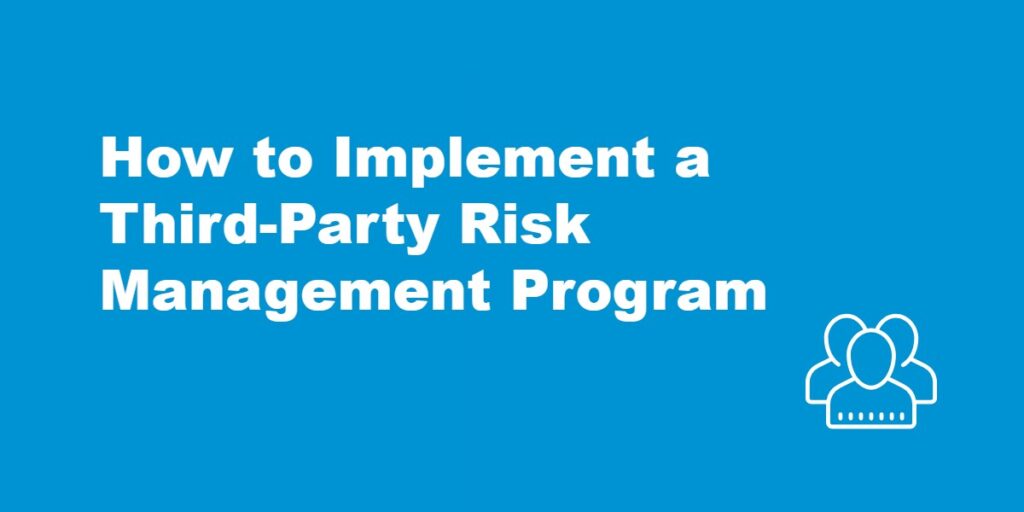No business is isolated today. Regardless of your industry and location, your business depends on third-party vendors, who are experts in their respective fields, to handle specialized tasks for you. For example, if you’re a manufacturing company, you will hire a cybersecurity company to keep your digital assets and systems secure from hackers and unauthorized users.
Due to this collaboration, managing the security of vendors becomes an important part of your own security process, as any breaches in their systems can impact yours. This is where Third-Party Risk Management (TPRM) comes in handy. This is a separate module offered by many GRC and risk management platforms to safeguard your business from breaches.
Read on, as we discuss the steps involved in implementing a TPRM program in your organization.
Understanding Third-Party Risk Management
To implement TPRM, you must understand what it is in the first place.
Third-party risk, in general, refers to any harm that can arise from using the services and systems of third-party entities. For context, third parties are those who are outside your organization, and include contractors, suppliers, vendors, consultants, partners, and service providers who access your organization’s resources without being a part of it. What this means is you have limited control over their operations and require contractors and checks to ensure they don’t misuse your resources. Additionally, if they have their own resources, they must secure it using the established best practices.
So, why does this matter?
The simple answer – cybersecurity and safeguarding your resources from potential risks. These risks can be classified into the following categories.
- Cybersecurity risk – Caused by weak security practices that can expose sensitive information.
- Operational risk – Occurs when your delivery of products or services is affected or delayed due to vendors’ failures.
- Compliance risk – When your vendor fails to meet any compliance requirements, and you are held accountable for these lapses.
- Reputation risk – Your reputation is impacted due to a breach, penalty, or unethical behavior of the vendor you deal with.
To avoid these risks and protect your organization from their financial implications, you need a TPRM.
Moreover, TPRM strengthens your IT security strategy by eliminating or reducing the entry and exit points of vendors to your organization’s critical resources. In this sense, TPRM allows only fewer people from your vendors’ organizations to access your resources, thereby reducing the surface area of attacks. Additionally, TPRM does a comprehensive background check of the vendors and assesses their security policies and their implementation. Accordingly, you can negotiate an agreement that will safeguard your assets.
Overall, TPRM is critical to avoid any risks that come from working with vendors. Without a TPRM, your organization may overlook these vulnerabilities, putting your operations at risk.
Now that you understand the importance of a TPRM, let’s talk about how you can implement it.
Implementing a Third-Party Risk Management Program
The implementation of a TPRM depends largely on the nature of your operations, the number of vendors you work with, the level of access they have to your resources, and the kind of services they offer for your business. Despite these variations, the broad steps are common, and they are explained below.
Step 1: Build an Inventory of all Third Parties
The first step is to understand your vendors and their resources. This involves creating and maintaining a comprehensive inventory, which can include,
- The name of your vendor.
- The services they offer.
- What systems and data do they access?
- Contract details and when they expire.
- Mandatory compliance standards that they follow.
- Any past instances of breach or non-compliance.
Based on the above factors, a TPRM tool can compute a risk score, which reflects their importance to your operations and the potential risks or losses that can come from them.
Make sure that this inventory is dynamic and is regularly updated to include new vendors and the changing risk profile of existing vendors.
Step 2: Classify Vendors Based on Risks
Once you have a comprehensive visibility into vendors and their operations, it’s time to classify the potential risks that they present. This classification will depend on the following factors.
- Level of access to your systems and resources.
- Sensitivity of the data they handle. For example, vendors who handle Personally Identifiable Information (PII) must have a higher risk score.
- Financial and operational impact of their operations on your business.
- Compliance requirements they must follow. For example, if they operate in the European Union, they must adhere to GDPR.
Based on these factors, classify vendors as critical if they access direct customer or employee data, high-risk when their operations are critical to your service and product delivery, medium-risk when they access a few non-critical systems, and low-risk when they perform low-sensitivity tasks. This classification enables you to tailor assessments and monitor activities geared to the risk level of each vendor.
Step 3: Conduct Due Diligence Before Onboarding
Based on the risk categorization, use a due diligence process for each vendor before onboarding them. This due diligence process involves a thorough vetting of the vendor’s background, security posture, policies, and history. Evaluate the vendor’s fit to your risk requirements and operations, and accordingly, create a TPRM plan.
Now comes an important question – how can you assess these risks?
Security questionnaires are a common tool used during this stage. It includes a set of questions that the vendor must answer honestly to help you assess their security and compliance. Check if they have encryption processes, incident response plans, compliance certifications, and physical security. If any vendor offers critical services, make sure to evaluate their past audit reports and documentation of their existing security controls.
Step 4: Include Risk Controls in Contracts
Using the findings in the previous step, evaluate what risk controls must be included in the contracts. Remember, legal contracts are a powerful way to enforce policies for risk mitigation. This is why every vendor contract must have specific clauses that address how the vendor will manage and address specific threats and scenarios.
Besides these specific clauses that depend on the vendor’s risk classification, make sure to also include standard clauses regarding data storage, access control, and documentation. Moreover, contracts must specify timelines for notifying your organization of any data breaches or problems within 24 hours of occurrence.
Other aspects to consider are the right to audit their systems through an external auditor to ensure compliance. You can also include termination clauses when the vendor does not meet the stipulations in the agreement.
Work closely with the legal, compliance, and procurement teams to create the right legal agreements that safeguard organizational assets and data.
Step 5: Have a Mechanism for Regular Audits
Create the necessary processes and use appropriate platforms to check if the vendor meets the obligations laid down in the contract. This process must also include tracking the status of certifications, monitoring performance metrics, evaluating data and access policies, reviewing service-level agreements, and more.
The audits also depend on the risk classification of the vendor. Ideally, critical vendors must be audited once or twice a year, while high-risk vendors can be audited once a year or once in two years. Low-risk vendors, on the other hand, can be monitored through security questionnaires where the onus is on them to answer these questions with honesty. Such regular audits provide real-time visibility into vendor performance and threat exposure.
Any identified incidents or red flags should trigger an immediate review of the vendor’s controls. Some aspects to look for are:
- Missed service levels.
- Negative press.
- Data breaches or any security-related incidents.
- Failed audits.
- Evidence of non-compliance.
Such continuous oversight safeguards your organization and reinforces vendor accountability.
Step 6: Integrate TPRM with Incident Management
TPRM must never exist in isolation, as it will not give the correct picture of what it means to your organization. Rather, TPRM must be integrated with your broader security incident management policies and frameworks. If you’re wondering why, it’s because their ability to respond to a security incident will have a direct impact on your ability to manage and even contain the impact of a threat.
Ideally, vendors must be a part of your incident response plans. You should also have a mechanism to share relevant intelligence with key vendors and even conduct regular joint exercises to keep everyone on the same page. Also, it helps to lay down the clear roles and responsibilities of vendors during an incident for a quicker and more streamlined response.
Such measures will offer greater control and visibility into third-party incidents.
Step 7: Automate Where Possible
As the number of third-party relationships grows, it may not be possible for you to manually stay on top of every incident or best practice. This is where automations come in, as they can handle the routine tasks, and bring your attention only to the critical ones. There are automated TPRM platforms that simplify vendor risk management by automating risk scoring, sending and receiving security questionnaires, flagging expired documents, and sending alerts about identified or emerging threats.
Automation tools also come in handy to improve reporting and auditing. They also store all relevant data in a central location to create a single source of truth and audit trails when needed.
While looking for TPRM tools, the following are some good-to-have capabilities.
- Workflow management.
- Integration with IT and procurement systems.
- Real-time monitoring.
- Report generation.
- Automatic alert sending to the admins.
Step 8: Report to Regulators
Transparency is essential when handling data access and compliance issues. It’s important to inform your board executives, regulators, vendors, and other stakeholders on how third-party risks are being handled in your organization. Also, sending regular reports to these stakeholders helps build trust.
In general, reports can include the following items.
- Active third-party vendors.
- The risk classification of each vendor.
- Assessment results.
- Remediation activities, if any.
- Important breaches or violations.
- The impact of reforms or measures implemented by the vendor.
- Any other security-related information.
While presenting these reports, use dashboards, charts, heat maps, and other visual tools for easy understanding and greater impact. Also, the reports must be in an accessible format and must implement access controls.
Step 9: Offer Regular Training
Your internal teams are the ones who will be monitoring and handling these third parties, so it’s essential that they have regular training and information to handle the emerging threats and compliance requirements. Every employee involved in the selection process must undergo training on what security aspects to look for while evaluating the vendors and their risks. Similarly, your security and IT teams must be familiar with the incident response protocols and actions when vendors report any security breaches. Make sure to rope in the legal and compliance teams while creating agreements.
Such cross-functional collaboration is critical for the success of any TPRM. Provide appropriate role-based training to each of these teams for an effective risk management culture.
Step 10: Continuous Review and Maintenance
TPRM is not a one-time implementation. Rather it is a continuous one, where you must regularly review the security profiles and actions of vendors, and make necessary changes to your processes and agreements. Such reviews can keep your program effective and relevant. It can also help you stay ahead of threats and protect your business from potential risks due to vendor activities.
Thus, these are the ten steps that can help you implement a comprehensive TPRM.
Final Words
To conclude, a TPRM is necessary to mitigate the risks that come from the operations of your vendors. However, taking a streamlined approach ensures that you go beyond just safeguarding your organization and evolve into a leader in building a risk-focused culture. This is an important transformation that can protect your organization in the long-run, especially as companies become more interconnected across geographies.


